Welcome to this post about one of Milan’s best known icons – La Scala Museum! Here’s all you need to know about our guide to one of Milan’s best museums with a very special tour guide!
People rarely visit museums and points of interest in their own hometowns. I think this statement is probably true worldwide – before I started MondaysInMilan in 2014, there were still many things to do in Milan I never bothered checking out, like the Monumental Cemetery and San Bernardino alle Ossa Church.
Another of these places is Museo Teatrale alla Scala (La Scala Theatre Museum), adjacent to the world-famous opera house. See, I come from a theatre-loving family, and I have been to the theatre itself several times – but I’ve never been into opera. I find it too long, too heavy, too hard to follow.
Also, I never actually visited the museum, highlighting the history of the theatre, from its foundation in the 18th century to the present day.
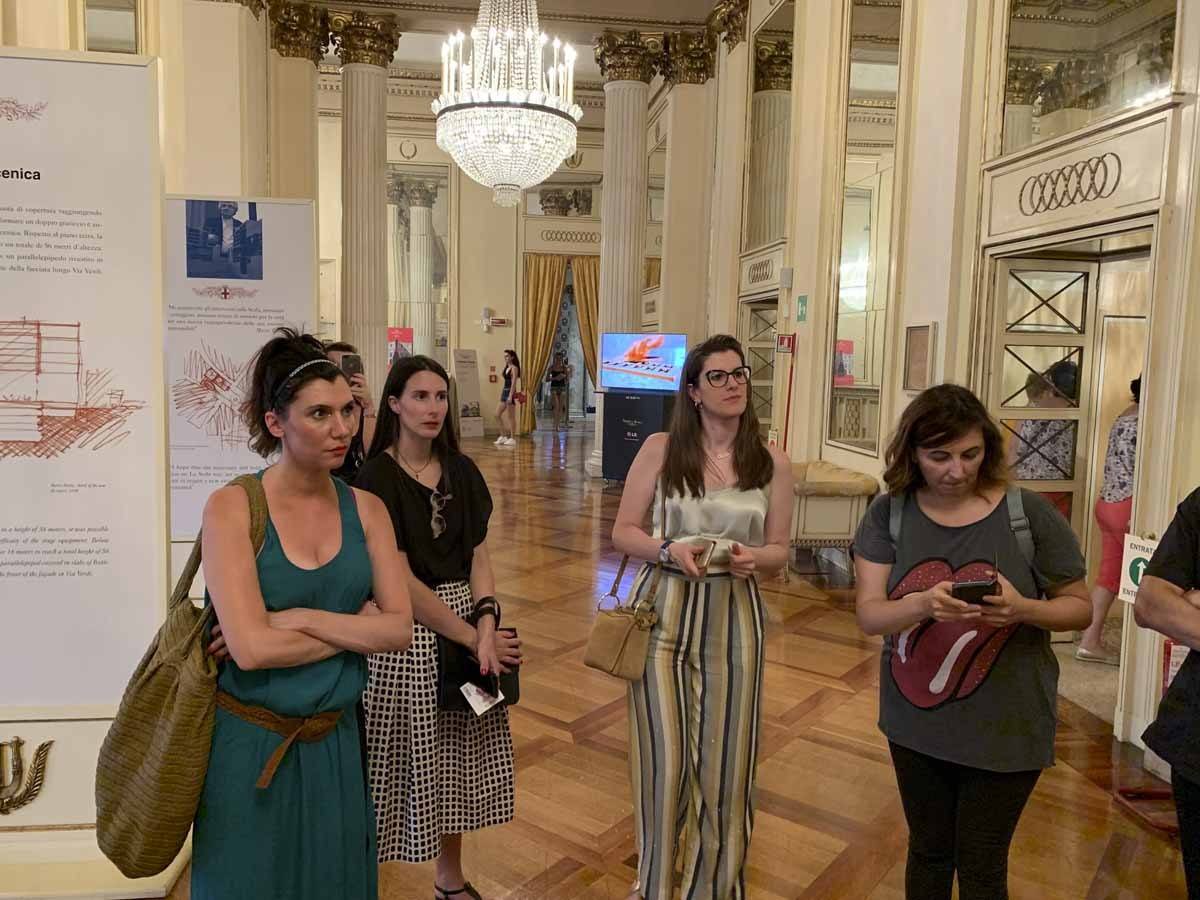
What is Guido Tour Sharing?
In early September 2019 I was invited to join a tour of La Scala Museum with Guido Tour Sharing, the same tour sharing operator we did a tour of Parco Sempione with.
Guido Tour Sharing was born from the desire of finding a fun, affordable way to discover museums, churches, castles, and other points of interest in the company of a qualified tour guide.

In Italy, tour guides need to pass a very hard exam to get a license. Exams are only held every few years and require years of studying – as a result, once they’re qualified, tour guides charge around €150-200 for a half-day tour, sometimes more.
Guido created a platform to browse and book shared guided tours on offer in Paris and several Italian cities. Guides post their availability and the tours on schedule, including themed tours, based on the individual guide’s interests and academic background.
For instance, our La Scala museum tour (obviously) had an opera focus, and our guide Fabio Tranchida was an opera aficionado and journalist – the perfect person to explore this fascinating museum with.
The Foyer of La Scala Theatre
Our tour began in front of the opera house, still sporting the same elegant, neoclassical look it had in 1778, when it was built.
Construction was commissioned to architect Giuseppe Piermarini following a decree by Austrian empress Maria Theresia, at the time ruling over the city, to replace the former opera house located in Milan’s Palazzo Reale, destroyed by a fire only two years prior.
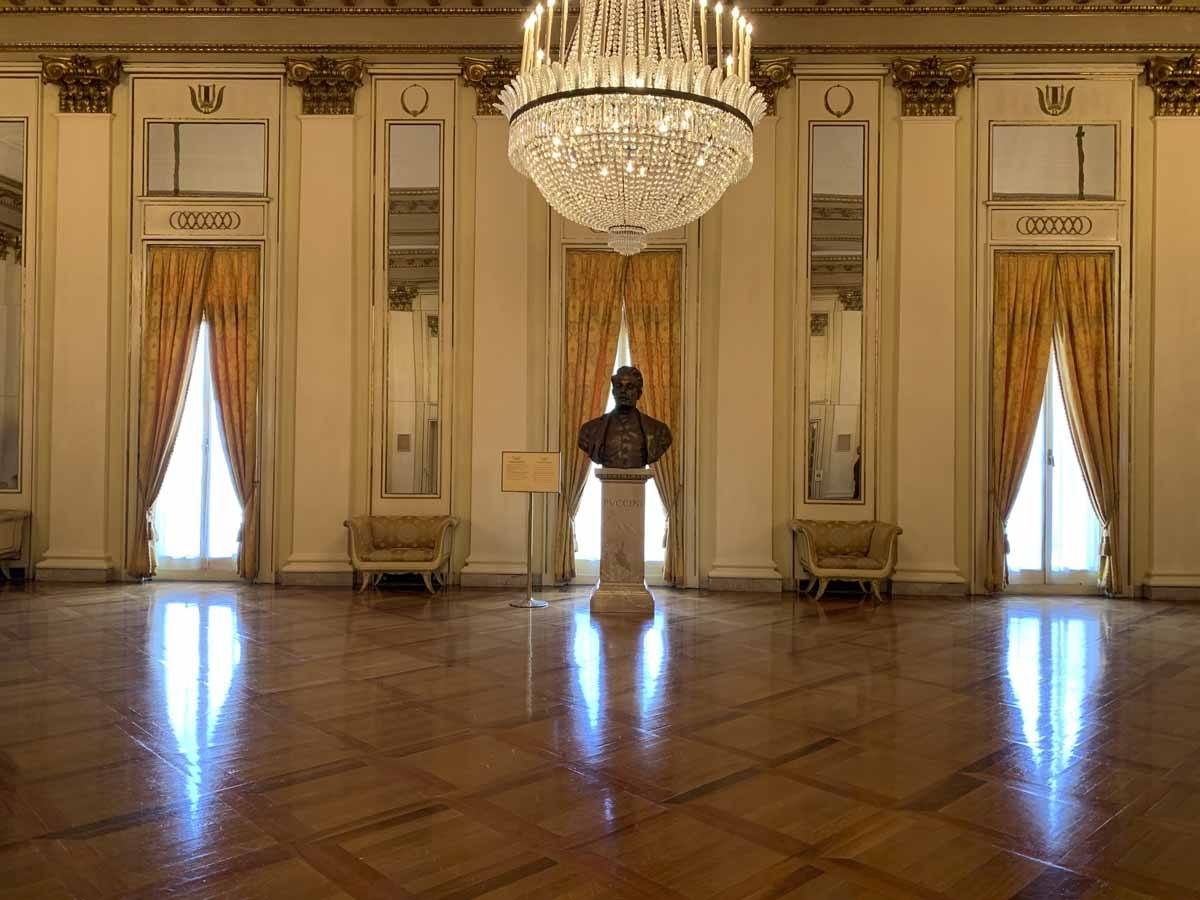
The theatre was built on the location of the church of Santa Maria alla Scala, after which it was named. The museum is accessed through the theatre foyer on the first floor, decorated with columns, chandeliers and busts of famed composers like Puccini and Toscanini.
‘Foyer’ means fireplace in French, and refers to the theatre’s entrance hall, where people gather before a show or in between acts. Traditionally, the foyer was the only place in a theatre with stone walls, meaning the only place where fireplaces could be kept to prevent fire hazards.
The current look of the foyer dates back to 1936. Fabio pointed out that the floor plan of La Scala foyer is still reminiscent of the former church, with two colonnades separating the wide hall into three ‘naves’.
At the centre of the hall, Fabio showed us a model of La Scala after the 2002/2004 renovation, the first one since the reconstruction after World War II.

The reconstruction was overseen by Swiss architect Mario Botta, who planned two ‘towers’ behind the theatre, to house the impressive collection of costumes and sceneries.
In contrast with La Scala’s neoclassical look, the towers look sleek and modern, which attracted considerable criticism. Fabio explained that Botta’s inspiration for the elliptical tower, the most peculiar-looking of the two, was the elliptical dome of nearby San Fedele Church.
Entering the La Scala Theatre
After touring the foyer, there was one more stop to do before entering the actual museum – we had the chance to look at the sumptuous La Scala Theatre interiors.
The inside of the theatre still looks very much the same as 1778, with deep red velvet curtains and seats, plus golden and ivory stucco decorations.
The theatre seats over 2000 people, divided between the parterre, four rows of boxes, and two gallery tiers – the topmost tier is the famous loggione, with standing room only.
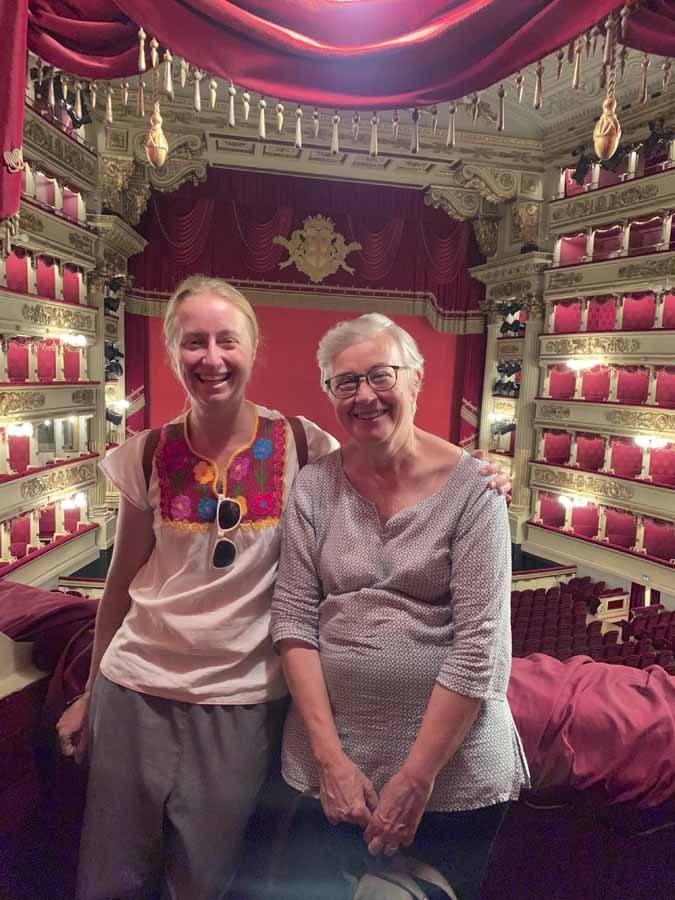
When rehearsals are not on, museum visitors are welcome to enter second-row boxes, some of the best seats in the house. La Scala boxes are small private ‘rooms’ accessed through a door, originally rented by wealthy families for the entire season.
I had been in the boxes before, so I was familiar with the (amazing) concept of being able to watch opera in your own little private room – but I had never noticed that each box had another small room right opposite, where servants used to prepare drink and snacks for wealthy theatregoers to be enjoyed during the show.
Fabio also pointed out a few other interesting features – like the huge Murano glass chandelier, donated by Murano glassmakers after WWII, and the unique clock right above the stage, with Roman numerals on a tape moving every 5 minutes.
As amazing as it is, La Scala looked a little weird completely empty, without the chatter of theatregoers, and the expectation when the orchestra takes their place, and the first notes fill the air.
Opera lovers or not, I recommend everyone to visit La Scala for a show, at least once in their lifetime.
Exploring La Scala Museum
However, that day we weren’t at La Scala for the opera. After taking a bit of time in the stalls, Fabio led us towards La Scala Museum, to begin the actual visit.

The museum was quite small, with only 8 rooms filled with objects, paintings, busts, statuettes and more – with not much in terms of descriptions.
If you have a keen interest for theatre, we really recommend visiting La Scala museum with a guide, or else you’ll probably amble aimlessly wondering what’s going on.
Fabio prepared for us a tour with a focus on the ‘divas’ of La Scala, the famous legendary soprano prime donne that drew crowds of admirers to these famed walls.
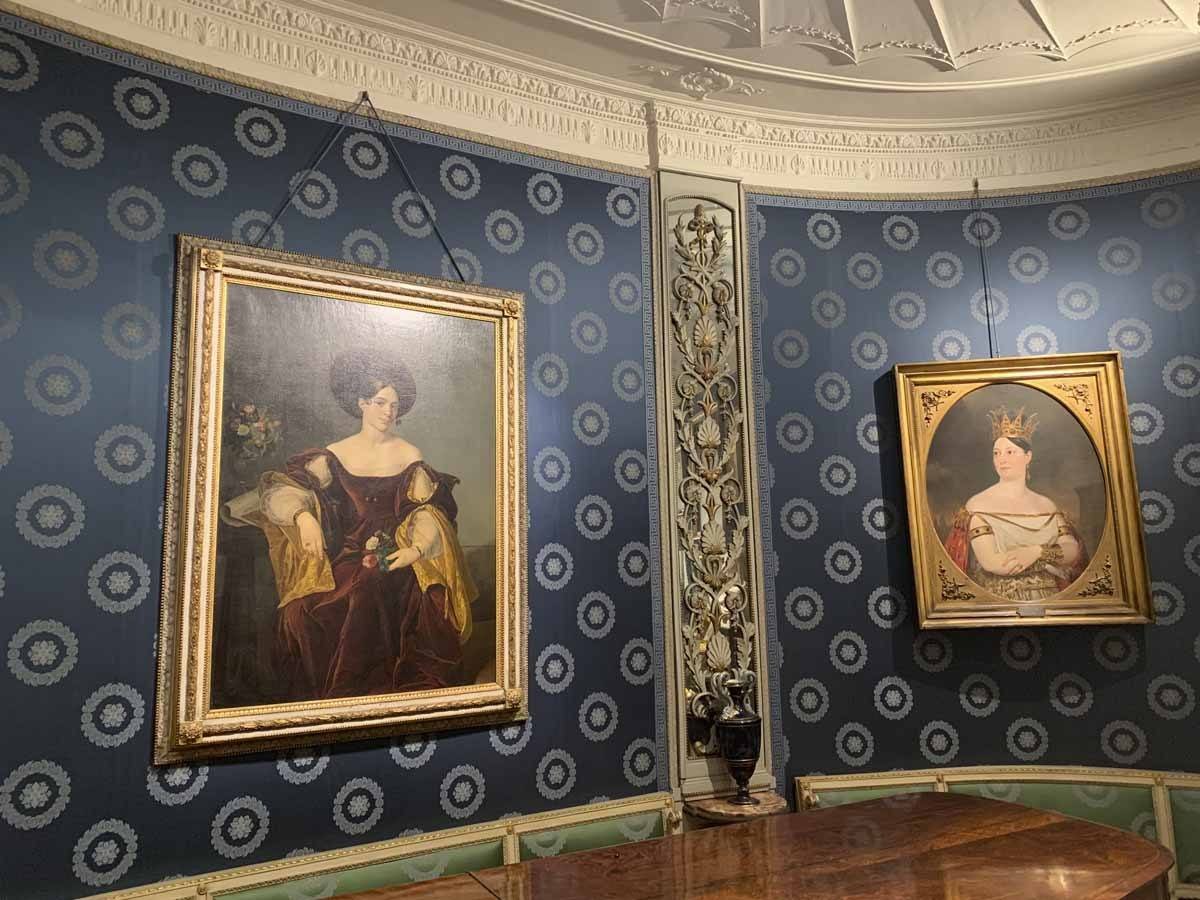
He also explained that sopranos were not always women – in the 18th century, many lead singers were actually castrato, male singers who were castrated before puberty to keep their voices high.
Each of the rooms in the La Scala theatre is dedicated to a different era in theatre history – starting with Baroque music in the 17th century, all the way through to the second half on the 20th century.
The second room is all about an all-Italian theatre genre – Commedia dell’Arte, a kind of pantomime which saw characters banter and joke on stage, first improvising, then following a script from the times of Carlo Goldoni onwards.
Commedia dell’Arte shows were (and still are) fun and quirky, foolish at times – and a little bit profane – as it could be seen by the pictures and ceramic figurines of Commedia dell’Arte characters we saw in the museum.
The Soprano Divas of La Scala
The theme of the following room was bel canto (meaning ‘beautiful singing’ in Italian), the Italian opera style popular during the first half of the 19th century.
This was the time of some of the greatest opera divas in history, like Giuditta Pasta, Isabella Colbran, and Maria Malibran – muses of famous composers, who wrote now-legendary arias to match their spellbinding voices.
Fabio was a knowledgeable and passionate guide – it was hard to keep track of time and of all the wonderful divas whose timeless voices graced the walls of La Scala.
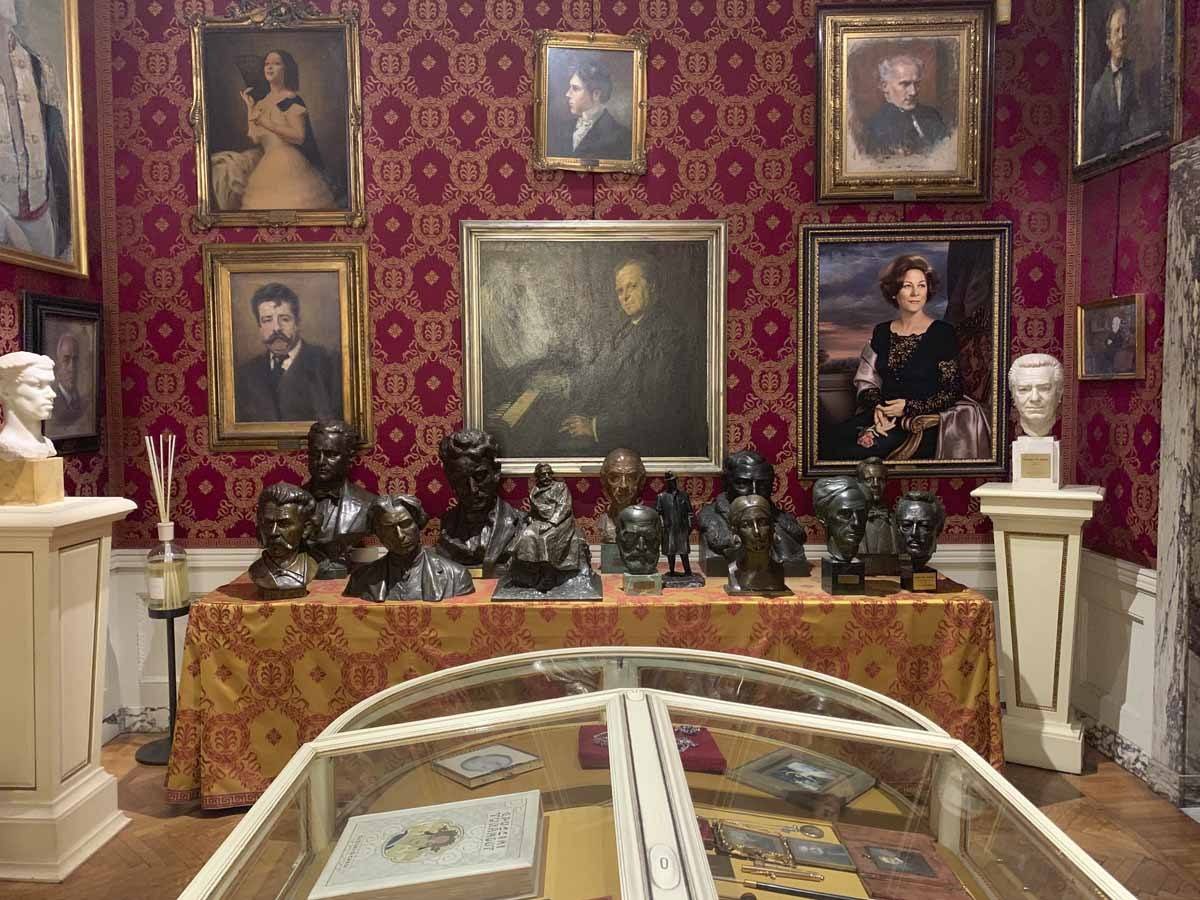
He told us about the sad death of Maria Malibran, who fell from a horse at the age of 28; about Giuseppina Ronzi de Begnis, Donizetti’s muse, who was famous for her performances of ‘mad scenes’; and about Giuseppina Strepponi, Verdi’s wife, who broke her voice after singing Nabucco.
Yet, my favourite story was that of the two Marchisio sisters, one soprano and one contralto, who performed love scenes together – one playing the diva, and the other one en travesti, playing the male hero.
An entire room was dedicated to Giuseppe Verdi, the composer who, perhaps more than any other, defined an entire operatic era at La Scala. He also passed away right next door, at the Grand Hotel et de Milan, and his room is now the hotel’s grandest suite.
No tour about opera divas is complete without mentioning Maria Callas, the great soprano who brought a renaissance of bel canto to La Scala in the mid-20th century.

The last room of the museum has a portrait of her, sitting on a chair, elegant and beautiful, in the simplicity of a black dress and pearl necklace. Right next to her, there’s a painting of Renata Tebaldi, her arch-rival, whose existence I ignored until this tour.
Our shared guided tour of La Scala Museum came to an end in front of Maria Callas’s portrait, but our experience continued in a nearby café, where we all enjoyed sharing our opera and theatre experiences with a nice Milanese aperitivo.
I am a bit of an oddball in a family of opera lovers – I tried, and tried, and tried to enjoy opera, but I always thought it’s not for me. This guided tour uncovered so many of the secrets underlying this unique musical art, that I’m thinking I might just give opera another go.
Who knows – maybe there’s an opera lover inside me!
This post was written in collaboration with Guido Tour Sharing. We would like to thank our awesome guide Fabio!
